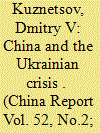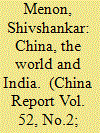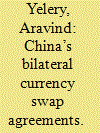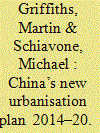|
|
|
Sort Order |
|
|
|
Items / Page
|
|
|
|
|
|
|
| Srl | Item |
| 1 |
ID:
144793


|
|
|
|
|
| Summary/Abstract |
This article examines China’s position on the Ukrainian ‘Euromaidan’ crisis over Crimea, on the war in the southeast of Ukraine and on sanctions against Russia. A complex set of reasons (economic, political and geopolitical) have caused heightened interest on the part of China in the events in the Ukraine. From the start, China kept a very low profile and right up to late February 2014, made no strong statements on the crisis in Ukraine and shunned any diplomatic initiatives. Thereafter, China’s official stand began to exhibit increasingly frequent signs of anti-Western rhetoric, an indication of its position over the situation in Ukraine nudging closer to that of the Russian Federation. China has swung gradually, and somewhat ambiguously, towards support for Russia primarily due to geopolitical reasons. Also, China and Russia share the desire to put up a united front in response to attempts by the United States and other Western countries to impose their attitudes on other countries.
|
|
|
|
|
|
|
|
|
|
|
|
|
|
|
|
| 2 |
ID:
144795


|
|
|
|
|
| Summary/Abstract |
After more than three decades of stupendous growth, China is in the process of making the painful transition to a lower growth path. As it does so, the ruling CPC is increasingly turning to nationalism to provide legitimacy in the eyes of its own people. China now openly seeks to ‘display its prowess’ and ‘assume its responsibilities’ in the world. However, it still lacks the capability to impose a political or security order of its own in its immediate neighbourhood. There is, therefore, likely to be a period of instability in the Asia–Pacific region, and the environment in which India pursues its interests will get more complex. China and India today have a relationship with elements of both cooperation and competition. While both countries have a common interest in improving on the existing security and economic order, they compete in the periphery they share. A danger present in present-day India–China relations comes from the mutual gap between perception and reality. Nevertheless, this article argues that this is a moment of opportunity for India–China relations, and that each country could benefit its core interests by working with the other.
|
|
|
|
|
|
|
|
|
|
|
|
|
|
|
|
| 3 |
ID:
144796


|
|
|
|
|
| Summary/Abstract |
China has recently demonstrated diverse ways to pursue its economic internationalisation. The trade mechanism has been re-modelled without a heavy tone on exports and China’s vulnerability to import–export risks has been steadily reduced. More than trade, the investments have been pursued to make Chinese economic expansion endure. Chinese also learned the trick of larger geo-economics by not waiting for crisis to occur and get caught in the global domino effect of slowdown, recession and other impulsive nature of markets. While, on one hand, China is trying to comply by international monetary and legal standards, making more space in a cluttered room for its economic ambitions, on the other, it is also adopting smarter ways to outperform the existing heavyweight economies’ dominance in the sphere of international monetary. An example of China’s sprint for maximising its legal and economic engagement and securing benefits by having bilateral currency swap agreements (BCS), exhibits how China has evolved over the last decade. A decade back, China was apprehensive about the BCS when it did not follow the Chiang Mai initiative. The current commentary attempts to analyse China’s BCS strategy and the possible impact.
|
|
|
|
|
|
|
|
|
|
|
|
|
|
|
|
| 4 |
ID:
144792


|
|
|
|
|
| Summary/Abstract |
Since 1978, China has emerged from being a predominantly agricultural economy to become the world’s largest economic power. Over the same period, the proportion of its population living in cities has more than doubled, from one fifth of the population in 1978 to more than half the population. Today, one tenth of the world’s population lives in Chinese cities. Over the past few years, there has been a growing concern over the sustainability of China’s economic development, which confronts a host of challenges, both external and internal. In light of those challenges, it has been suggested by many commentators that, among other policy changes, China will have to shift from its dependence on exports to a greater focus on domestic consumption. In this article we suggest that what has been dubbed the ‘new urbanisation’ by Chinese authorities is a useful lens through which to assess both the opportunities and challenges facing China as it navigates a path to more sustainable economic growth over the next few decades. It also provides a counterbalance to those commentators who focus solely on China’s growing military power as evidence of a rising China compared to the United States.
|
|
|
|
|
|
|
|
|
|
|
|
|
|
|
|
| 5 |
ID:
144794


|
|
|
|
|
| Summary/Abstract |
Vietnam and India have had good political relations since the two countries gained independence in the 1940s. Despite the good political ties, however, economic collaboration was not a priority in bilateral relations until the 1990s. After 1990, the situation started to change as Vietnam began implementing its opening up policy and India saw Vietnam as an important partner in the deployment of its Look East Policy. Thus, both Vietnam and India have made great efforts to promote trade and investment cooperation between the two countries. Certain difficulties, nevertheless, continue to hinder bilateral economic relations. This paper is an attempt to analyse Vietnam–India economic relations since the two countries established a strategic partnership in 2007, with a focus on the economic advantages and needs of Vietnam and India, the current situation of Vietnam–India economic relations, and prospects for the further development of these relations.
|
|
|
|
|
|
|
|
|
|
|
|
|
|
|
|
|
|
|
|
|